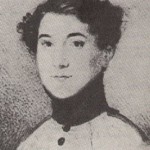Sister in Law Beethoven
“I will now fight a battle for the purpose of taking a poor, unhappy child from the clutches of his unworthy mother. I will win the day! I am husband and father – senza wife!” Ludwig van Beethoven
Sister in Law Beethoven– synopsis
Before Beethoven’s corpse was yet cold, several of his well-meaning or self-serving friends and confidants removed a dozen conversation books from the composer’s apartment. These  confiscated conversation books, writing pads that the deaf Beethoven wrote in to communicate, contained insane ramblings about his sister-in-law and her son, Karl.In 1815, Ludwig’s brother Caspar Carl died at the age of 41, leaving behind his widow, Johanna, and their nine-year old son, Karl. For the next 10 years, Ludwig battled Johanna personally and through the courts for custody of the sole Beethoven heir. Ludwig served as his own legal counsel, and among his many fraudulent claims were that he was related to nobility, that Johanna was nothing more than a harlot, that Karl was the next Mozart or perhaps Goethe, and that the composer cum lawyer was the only one suited on terra firma to raise his nephew.
confiscated conversation books, writing pads that the deaf Beethoven wrote in to communicate, contained insane ramblings about his sister-in-law and her son, Karl.In 1815, Ludwig’s brother Caspar Carl died at the age of 41, leaving behind his widow, Johanna, and their nine-year old son, Karl. For the next 10 years, Ludwig battled Johanna personally and through the courts for custody of the sole Beethoven heir. Ludwig served as his own legal counsel, and among his many fraudulent claims were that he was related to nobility, that Johanna was nothing more than a harlot, that Karl was the next Mozart or perhaps Goethe, and that the composer cum lawyer was the only one suited on terra firma to raise his nephew.
Three court cases ran for years (one is reminded of Dickens), and the insanity stopped only after Karl, in desperation to free himself of his uncle’s impossible demands, attempted suicide. One bullet misfired, the other grazed Karl’s skull, and this scream for deliverance brought Ludwig back to a semblance of reality before his death a year later.
Several audience members have informed me that I was maligning the mighty composer. Never! First, It is wholly remarkable that during this time of mental chaos he was composing such works as the Ninth Symphony. And despite the utter folly, Beethoven was attempting to re-create an idealized family life; one that he and his brother Caspar Carl were deprived of with beatings and rages by their drunken father. A madness with hoped for change: Ode to Joy—O friends, no more these sounds! Let us sing more cheerful songs, more full of joy!
Margot Kidder as Johanna van Beethoven
 Born Margaret Ruth Kidder to Jill Kidder and Kendall Kidder, a mining engineer, in Yellowknife, Canada, on October 17, 1948, Margot was a delightful child who took pride in everything she did. After graduation Margot moved to Los Angeles to start a film career. She found herself dealing with a lot of prejudice, and hotheads, but later found solace with a Canadian agent. This was when she got her first acting job, in the Norman Jewison film Gaily, Gaily (1969). This led to another starring role in Quackser Fortune Has a Cousin in the Bronx (1970), in which she co-starred with Gene Wilder. After some harsh words from the film’s director, Margot temporarily left films to study acting in New York. When she arrived in Hollywood she met up at a screen test with actress Jennifer Salt, resulting in a friendship that still stands strong today. Margot and Jennifer moved into a lofty beach house and befriended other, then unknown, struggling filmmakers such as Martin Scorsese, Brian De Palma, Steven Spielberg and Susan Sarandon, among others. De Palma gave her the script to his upcoming film Sisters (1973). Margot and Salt both had the leads in the film, and it was a huge critical success.
Born Margaret Ruth Kidder to Jill Kidder and Kendall Kidder, a mining engineer, in Yellowknife, Canada, on October 17, 1948, Margot was a delightful child who took pride in everything she did. After graduation Margot moved to Los Angeles to start a film career. She found herself dealing with a lot of prejudice, and hotheads, but later found solace with a Canadian agent. This was when she got her first acting job, in the Norman Jewison film Gaily, Gaily (1969). This led to another starring role in Quackser Fortune Has a Cousin in the Bronx (1970), in which she co-starred with Gene Wilder. After some harsh words from the film’s director, Margot temporarily left films to study acting in New York. When she arrived in Hollywood she met up at a screen test with actress Jennifer Salt, resulting in a friendship that still stands strong today. Margot and Jennifer moved into a lofty beach house and befriended other, then unknown, struggling filmmakers such as Martin Scorsese, Brian De Palma, Steven Spielberg and Susan Sarandon, among others. De Palma gave her the script to his upcoming film Sisters (1973). Margot and Salt both had the leads in the film, and it was a huge critical success.
The film made branded Margot as a major talent, and in the following years she starred in a string of critically acclaimed pictures, such as Black Christmas (1974), The Great Waldo Pepper (1975), 92 in the Shade (1975) – directed by Thomas McGuane, who was also her husband for a brief period – and a somewhat prophetic tale of self-resurrection, The Reincarnation of Peter Proud (1975).
Her new agent hooked her up with a little-known director named Richard Donner. He was going to be directing a film called Superman (1978), and she auditioned for and secured the leading female role of Lois Lane. That film and Superman II (1980) were to be filmed simultaneously. After the success of “Superman” she took on more intense roles, such as The Amityville Horror (1979) and Willie & Phil (1980). After that, Margot did numerous films, television and theater work throughout the 1980s, including Superman IV: The Quest for Peace (1987). When the 1990s erupted with the Gulf War, Margot found herself becoming involved in politics. She made a stir in the biz when she spoke out against the military for their actions in Kuwait. She also appeared in a cameo in Donner’s Maverick (1994).
Margot has had continued success in film and on TV and even had a guest-star role on a newer version of Superman which fans al know and love called SMALLVILLE! PLUS SEE HERE IN THE NEW ROB ZOMBIE film H2 (Halloween II)!!!!
Margot is currently writing a book and tours the world meeting fans at conventions and also is a highly sought after speaker for the Mental Health field appearing a numerous seminars to educate people on mental health issues.
IMDb Mini Biography By: Briarwood With edits and additions by CWPLLC.
Music by Beethoven for cello and piano performed by the Clark Schudmann Duo
This program is generously sponsored by Diana Varecka
